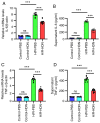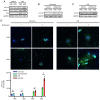Potential protective effect of hesperidin on hypoxia/reoxygenation-induced hepatocyte injury
- PMID: 34035861
- PMCID: PMC8135133
- DOI: 10.3892/etm.2021.10196
Potential protective effect of hesperidin on hypoxia/reoxygenation-induced hepatocyte injury
Abstract
Hesperidin (HDN) has been reported to have hydrogen radical- and hydrogen peroxide-removal activities and to serve an antioxidant role in biological systems. However, whether HDN protects hepatocytes (HCs) against hypoxia/reoxygenation (H/R)-induced injury remains unknown. The present study aimed to explore the role of HDN in H/R-induced injury. HCs were isolated and cultured under H/R conditions with or without HDN treatment. HC damage was markedly induced under H/R, as indicated by cell viability, supernatant lactate dehydrogenase levels and alanine aminotransferase levels; however, HDN treatment significantly reversed HC injury. Oxidative stress markers (malondialdehyde, superoxide dismutase, glutathioneand reactive oxygen species) were increased markedly during H/R in HCs; however, this effect was significantly attenuated after exposure to HDN. Compared with those of the control group, the mRNA expression levels of IL-6 and TNF-α in HCs and the concentrations of IL-6 and TNF-α in the supernatants increased significantly following H/R, and HDN significantly ameliorated these effects. Western blotting demonstrated that microtubule-associated protein 1 light chain 3α (MAP1LC3A, also known as LC3) and Beclin-1 protein expression levels increased, while sequestosome 1 levels decreased during H/R following exposure to HDN. The number of GFP-LC3 puncta in HCs following exposure to HDN was increased compared with that observed in HCs without HDN exposure under the H/R conditions after bafilomycin A1 treatment. In summary, the present study demonstrated that HDN attenuated HC oxidative stress and inflammatory responses while enhancing autophagy during H/R. HDN may have a potential protective effect on HCs during H/R-induced injury.
Keywords: autophagy; hepatocyte; hesperidin; hypoxia/reoxygenation; oxidative stress.
Copyright: © Li et al.
Conflict of interest statement
The authors declare that they have no competing interests.
Figures





Similar articles
-
Hesperidin ameliorates liver ischemia/reperfusion injury via activation of the Akt pathway.Mol Med Rep. 2020 Dec;22(6):4519-4530. doi: 10.3892/mmr.2020.11561. Epub 2020 Oct 6. Mol Med Rep. 2020. PMID: 33174025 Free PMC article.
-
Hesperidin protects against stress induced gastric ulcer through regulation of peroxisome proliferator activator receptor gamma in diabetic rats.Chem Biol Interact. 2018 Aug 1;291:153-161. doi: 10.1016/j.cbi.2018.06.027. Epub 2018 Jun 23. Chem Biol Interact. 2018. PMID: 29944876
-
Protective effects of hesperidin on concanavalin A-induced hepatic injury in mice.Int Immunopharmacol. 2014 Aug;21(2):406-11. doi: 10.1016/j.intimp.2014.05.018. Epub 2014 May 24. Int Immunopharmacol. 2014. PMID: 24867793
-
rTFPI Protects Cardiomyocytes from Hypoxia/Reoxygenation Injury through Inhibiting Autophagy and the Class III PI3K/Beclin-1 Pathway.Cell Biochem Biophys. 2023 Mar;81(1):97-104. doi: 10.1007/s12013-022-01113-0. Epub 2022 Oct 30. Cell Biochem Biophys. 2023. PMID: 36309623
-
The mitigation mechanism of hesperidin on deoxynivalenol toxicity in grass carp hepatocytes via decreasing ROS accumulation and inhibiting JNK phosphorylation.Fish Shellfish Immunol. 2023 Mar;134:108646. doi: 10.1016/j.fsi.2023.108646. Epub 2023 Feb 25. Fish Shellfish Immunol. 2023. PMID: 36842640
Cited by
-
Hesperidin alleviates pulmonary fibrosis by regulating EI24-mediated autophagy.Future Sci OA. 2025 Dec;11(1):2483147. doi: 10.1080/20565623.2025.2483147. Epub 2025 Mar 28. Future Sci OA. 2025. PMID: 40155367 Free PMC article.
-
Hesperidin Exhibits Protective Effects against PM2.5-Mediated Mitochondrial Damage, Cell Cycle Arrest, and Cellular Senescence in Human HaCaT Keratinocytes.Molecules. 2022 Jul 27;27(15):4800. doi: 10.3390/molecules27154800. Molecules. 2022. PMID: 35956749 Free PMC article.
-
Systemic Dietary Hesperidin Modulation of Osteoclastogenesis, Bone Homeostasis and Periodontal Disease in Mice.Int J Mol Sci. 2022 Jun 26;23(13):7100. doi: 10.3390/ijms23137100. Int J Mol Sci. 2022. PMID: 35806105 Free PMC article.
References
-
- Halladin NL. Oxidative and inflammatory biomarkers of ischemia and reperfusion injuries. Dan Med J. 2015;62(B5054) - PubMed
LinkOut - more resources
Full Text Sources
Other Literature Sources
Research Materials
